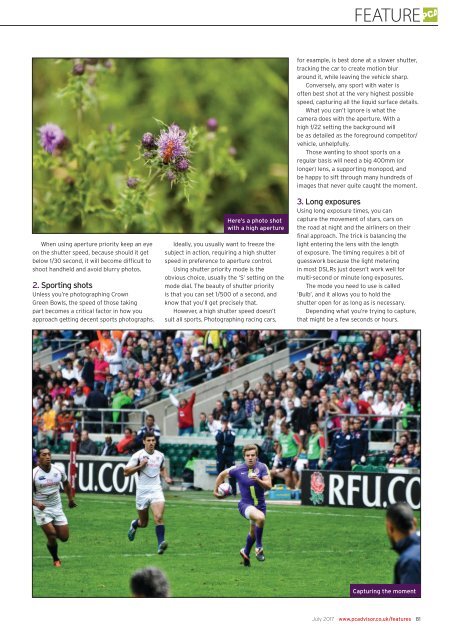You also want an ePaper? Increase the reach of your titles
YUMPU automatically turns print PDFs into web optimized ePapers that Google loves.
FEATURE<br />
When using aperture priority keep an eye<br />
on the shutter speed, because should it get<br />
below 1/30 second, it will become difficult to<br />
shoot handheld and avoid blurry photos.<br />
2. Sporting shots<br />
Unless you’re photographing Crown<br />
Green Bowls, the speed of those taking<br />
part becomes a critical factor in how you<br />
approach getting decent sports photographs.<br />
Here’s a photo shot<br />
with a high aperture<br />
Ideally, you usually want to freeze the<br />
subject in action, requiring a high shutter<br />
speed in preference to aperture control.<br />
Using shutter priority mode is the<br />
obvious choice, usually the ‘S’ setting on the<br />
mode dial. The beauty of shutter priority<br />
is that you can set 1/500 of a second, and<br />
know that you’ll get precisely that.<br />
However, a high shutter speed doesn’t<br />
suit all sports. Photographing racing cars,<br />
for example, is best done at a slower shutter,<br />
tracking the car to create motion blur<br />
around it, while leaving the vehicle sharp.<br />
Conversely, any sport with water is<br />
often best shot at the very highest possible<br />
speed, capturing all the liquid surface details.<br />
What you can’t ignore is what the<br />
camera does with the aperture. With a<br />
high f/22 setting the background will<br />
be as detailed as the foreground competitor/<br />
vehicle, unhelpfully.<br />
Those wanting to shoot sports on a<br />
regular basis will need a big 400mm (or<br />
longer) lens, a supporting monopod, and<br />
be happy to sift through many hundreds of<br />
images that never quite caught the moment.<br />
3. Long exposures<br />
Using long exposure times, you can<br />
capture the movement of stars, cars on<br />
the road at night and the airliners on their<br />
final approach. The trick is balancing the<br />
light entering the lens with the length<br />
of exposure. The timing requires a bit of<br />
guesswork because the light metering<br />
in most DSLRs just doesn’t work well for<br />
multi‐second or minute long exposures.<br />
The mode you need to use is called<br />
‘Bulb’, and it allows you to hold the<br />
shutter open for as long as is necessary.<br />
Depending what you’re trying to capture,<br />
that might be a few seconds or hours.<br />
Capturing the moment<br />
<strong>July</strong> <strong>2017</strong> www.pcadvisor.co.uk/features 81


















